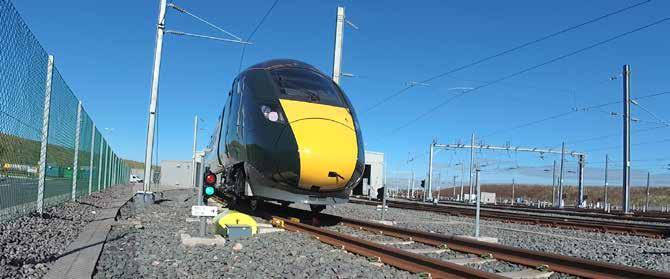44
ROLLING STOCK/DEPOTS
SC OT TRAIN LA ND EN G ’S RO D Y
H
DAVID SHIRRES
R
ail Engineer’s recent feature on hydrogen trains mentioned plans to produce a hydrogen demonstrator train in Scotland, but it went to press before the announcement of the contract award. As this initiative has much of interest, in both the train and the UK’s decarbonisation strategy, we hope readers will agree that it is worthy of another hydrogen-train article. Both the Committee on Climate Change’s Net Zero report and the National Grid’s Future Energy Scenarios conclude that hydrogen will have a key role in the decarbonisation of the energy system. They consider that replacing fossil fuels requires an increase in both zero-carbon electrical generation and hydrogen production. This would provide power beyond the fixed electrical distribution system and could also be used for heating, for example for high temperature industrial processes and domestic heating using the existing gas grid. In November, HM Government published its Ten Point Plan for a Green Industrial Revolution. One of these points was driving the growth of lowcarbon hydrogen, which it considers will potentially unlock 100,000 jobs by 2050. In Scotland, the devolved government’s ‘Scottish Hydrogen Assessment’ was published in December. This concluded that Scotland could produce significant quantities of green hydrogen from offshore wind. It also considered three scenarios for hydrogen production in 2045, which ranged between 20 and 127TWh. In these scenarios, transport would consume between 7 and 22TWh of hydrogen production and the value to the economy was estimated at between £5.7 and £25.9 billion resulting in between 68,000 and 313,000 jobs by 2045.
Rail Engineer | Issue 188 | Jan-Feb 2021
Accelerating hydrogen In July, the Scottish Government announced that it was to invest £300,000 in a hydrogen accelerator at the University of St Andrews to support delivery of its target of net-zero carbon by 2045. This requires the University to collaborate with relevant Scottish institutions to drive hydrogen technology innovations and to encourage knowledge sharing and the development of expertise to support transport applications. It also aims to maximise the economic opportunities from the shift to zero or ultra-low emission transport by fostering new partnerships between industry and government.
Thus, this supports Transport Scotland’s transport decarbonisation plan and Scottish Enterprise’s requirement to develop the supply chain to support Scotland’s green recovery. In September, the University of St Andrews announced that it was seeking a partner for the next phase of the production of a hydrogen train demonstrator. This scheme had been developed by Scottish Enterprise and Transport Scotland. Its first phase had been a concept design for conversion of a Class 314 EMU that had been jointly developed by Brodie Engineering of Kilmarnock and Arcola Energy. The contract notice for the second phase required a hydrogen train to be demonstrated on the Bo’ness and Kinneil heritage railway and available for the COP26 world environmental summit in Glasgow in November. It had an estimated contract value of £2.74 million and stated













